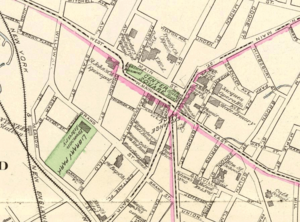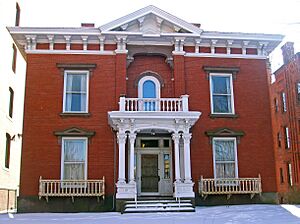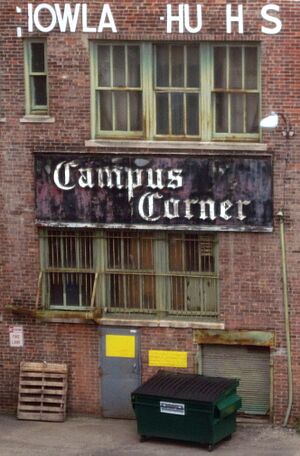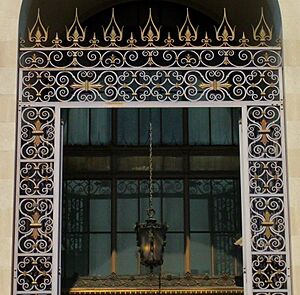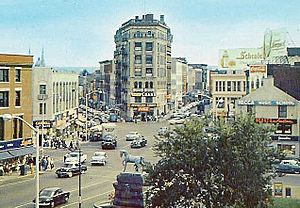Downtown Waterbury Historic District facts for kids
Quick facts for kids |
|
|
Downtown Waterbury Historic District
|
|
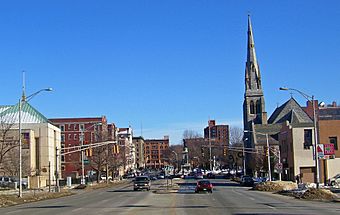
View down West Main Street to Waterbury Green from Meadow Street, 2009
|
|
| Location | Waterbury, CT |
|---|---|
| Area | 75 acres (30 ha) |
| Built | Late 19th–Early 20th centuries |
| Architect | Various |
| Architectural style | Various contemporary styles |
| NRHP reference No. | 83001280 |
| Added to NRHP | 1983 |
The Downtown Waterbury Historic District is the main part of Waterbury, a city in Connecticut, USA. It's a rectangular area around West Main Street and Waterbury Green. The Green is an old town park, known as one of the prettiest in New England.
The Green was Waterbury's first center. Buildings around it were homes, churches, and public offices. Many early buildings were removed as the city grew and became industrial. Later, Exchange Place became a hub for shops. A huge fire in 1902 destroyed many buildings there. After the fire, the city's government buildings moved to a new complex. This new area was designed by Cass Gilbert, following the "City Beautiful movement" idea.
Most buildings in the district are large commercial blocks. They were built when the city's industries were booming, in the late 1800s and early 1900s. Some older buildings survived the 1902 fire. Famous architects like Henry Bacon and Henry Dudley designed buildings here. You can see different styles, such as Second Renaissance Revival, Georgian Revival, and Romanesque Revival.
In 1983, this area was recognized as a historic district. It was added to the National Register of Historic Places. At that time, three other places within the district were already listed. These included the city complex and two houses. Another old hotel has also been added since then.
Contents
What Does the Downtown Waterbury Historic District Look Like?
The district covers about 75-acre (30 ha). It is located between the railroad tracks along the Naugatuck River and the University of Connecticut's Waterbury campus. This area is very developed, with many tall buildings used for different purposes. There are 130 buildings in total. Six other objects and one structure also add to its historical value.
Some buildings are newer or have been changed. These are not considered part of the historic look. The oldest buildings date back to the 1800s. There are also large parking lots and two small parks. These parks are Waterbury Green and Library Park. They offer open green spaces in the city. The land is mostly flat, as it used to be a flood plain near the river.
If you drive on Interstate 84 to the south, you can see the city's skyline. The highway is on a raised bridge, giving a great view.
The district's boundaries are a bit complex. It starts at State and West Main streets. It goes along West Main Street, then turns north. It includes Immaculate Conception Church. Then it turns south on North Main Street, and east along East Main Street. The district ends at the open square where East Main, North Elm, and South Elm streets meet.
From there, it cuts diagonally across some streets. It includes the armory and Library Park. It also includes the old American Brass Company headquarters. Finally, it follows Meadow Street back to Grand Street, and then State Street back to the start.
Leavenworth Street divides the district into two main parts. To the east, buildings are packed closely together. This area is centered around Exchange Place. To the west, buildings are mostly public or institutional. These include the Waterbury Municipal Center Complex. These buildings have larger spaces between them.
A Look Back: History of Downtown Waterbury
Downtown Waterbury's history can be split into four main periods. These are similar to the city's overall history. They include the early settlement, the industrial age, the planned rebuilding after a big fire, and the time since World War II.
Early Years (1677–1820): Before Factories Arrived
Waterbury started as a small farming community in the 1670s. Its growth was slow at first due to floods and sickness. Farming was also difficult. Even after the American Revolution, the population hadn't grown much.
Factories began to appear in the early 1820s. Companies making carriages, buttons, and clocks came here. They liked the water power from the many streams flowing into the Naugatuck River. This is how the town got its name, meaning "water-town." Local business people started making brass to supply these factories. They learned from British experts. This began the brass industry that Waterbury became famous for.
The factory owners started changing the city. They suggested creating a town green. On July 4, 1825, people gathered to clear large rocks from a swampy area. This was the old town common where early settlers had built homes. In the next years, the town drained and leveled the area. They also moved streets and the old meeting house. By 1842, it was fenced off. It was officially named Center Square in 1849, but people still called it Waterbury Green.
Few old buildings remain in Waterbury. This is because of all the rebuilding that happened. The oldest building in the district is from 1835. It's a Greek Revival style building at 67–73 South Main Street. Its outside has been changed a lot over time.
Industrial Boom (1825–1902): Waterbury Grows Fast
Waterbury grew steadily. It officially became a city in 1853. By 1860, its population had doubled to over 10,000 people. During this time, Exchange Place became the main business center. The Greek Revival buildings there show this era.
Waterbury Green continued to develop. It was surrounded by public and private buildings. These included City Hall and the library. A flagpole was added in 1851. In 1884, the Soldiers' Monument was added to honor Civil War veterans. Four years later, the Welton Fountain joined it. This fountain honored its donor's favorite horse.
Factories moved to bigger spaces outside the city center as Waterbury expanded. Shops moved into larger buildings. Examples include the 1888 Romanesque Revival Platt Block and the 1890 Queen Anne Hanlon Block. The 1894 Apothecaries' Hall became the main building at Exchange Place. It is a seven-story, flatiron-shaped building.
Local architects started making their mark. Wilfred E. Griggs designed the Odd Fellows Hall in 1893. It used a rare Venetian Gothic style. This building showed the growing role of fraternal organizations in the city. The 1889 Richardsonian Romanesque St. Patrick's Hall showed the rise of Irish Americans. Its architect, Joseph A. Jackson, was the son of an Irish immigrant.
Wealthy residents built grand homes on West Main Street. The John Kendrick House is an example. Churches also followed, like Henry C. Dudley's St. John's Episcopal Church from 1873. In 1894, the Silas Bronson library moved to its current spot on Grand Street. This was the first major public building to move.
Rebuilding and Planning (1902–1945): A New Downtown
By 1900, Waterbury made almost half of all American brass. The city's strong industries helped it recover from a huge fire in 1902. This fire destroyed 42 buildings downtown. After the fire, the city rebuilt. Many of the district's unique buildings came from this time.
The first new building was the Second Renaissance Revival Howland Hughes department store. It opened in 1903. Architect Wilfred E. Griggs then designed the Elton Hotel in 1904 and the Masonic Temple in 1912. These large buildings kept downtown as the city's economic center. They also pushed out all remaining homes. Some homes were turned into offices. Large apartment buildings were also built nearby.
The city also created a new Library Park. Old commercial buildings were torn down. Streets were straightened to make a nice area for the new Waterbury Union Station. This station opened in 1909. Its 240-foot (73 m) clock tower became a city landmark. It looks like the Torre del Mangia in Siena, Italy.
Within the district, American Brass built its Renaissance Revival headquarters in 1913. It faced the station. The Georgian Revival Waterbury City Hall was completed in 1917. It was designed by Cass Gilbert. Gilbert also designed the Chase Headquarters Building for another brass company. Other large buildings, mostly banks, filled Grand Street. This was part of the "City Beautiful movement" plan. The goal was to create impressive views around the commercial center at Exchange Place.
During World War I, Waterbury's brass mills worked constantly for military orders. This prosperity continued into the Roaring Twenties. New buildings were added. These included the Georgian Revival YMCA building and Gilbert's Waterbury Savings Bank. Henry Bacon designed the Citizen's and Manufacturer's Bank in 1921. The Palace Theater opened in 1922. It became the city's main theater. Later, the Baroque Revival Immaculate Conception Church was built in 1928. It showed the growth of Waterbury's Catholic immigrant communities.
The last major architectural styles downtown were Art Deco and modernist. These came just before the Great Depression stopped most new construction. Examples include the 1930 Brown Building and the 1931 Art Deco post office. The Telephone Building from the same year used modern brick designs on a Georgian Revival style.
Modern Era (1946–Present): Changes and Renewal
Prosperity returned during World War II. The brass mills worked non-stop again. But this time, the good times did not last after the war. Plastics started replacing brass in products. Downtown also suffered as veterans wanted to live in suburbs. They wanted single-family homes with yards, which were not available downtown. This led to a need for new roads for cars. Some buildings were torn down to build these roads.
The district saw mixed effects. Bus routes replaced trolley lines, still meeting at Exchange Place. But later urban renewal projects removed some important buildings. Other historic buildings were modernized so much that they lost their original look.
New construction continued. The new UConn campus took up much of the cleared land. A new Bronson Library was built in 1963. A new state courthouse followed in 1974. Downtown has remained the economic center of Waterbury. Many local banks still have offices around the Green.
In the early 2000s, City Hall was in bad shape. In 2006, voters rejected a plan to fix it. But the city's Board of Aldermen approved a plan in 2007. The rebuilt City Hall opened in early 2011.
Important Historic Buildings and Places
When the district was first listed, three places within it were already on the National Register. One more has been added since. Many other buildings also contribute to the district's history. Some might be listed on the Register in the future.
Places on the National Register of Historic Places
- Elton Hotel, 16–30 West Main Street. This six-story brick building was designed by Wilfred E. Griggs. It has been a landmark on the Green since 1904. Today, it is a senior living facility.
- Enoch Hubbard and George Granniss Houses, 33 and 41 Church Street. These two wooden houses are from the 1860s. They are among the few single-family homes left downtown. Both are now used for businesses.
- John Kendrick House, 119 West Main Street. The Mattatuck Museum runs this brick house on the Green. It was also built in the 1860s.
- Waterbury Municipal Center Complex, Grand and Field streets. Waterbury's City Hall is surrounded by other large buildings. These were designed by Cass Gilbert and built between 1914 and 1922.
Other Notable Historic Places
- American Brass Company Building, 414–436 Meadow Street. This brick building was the headquarters of the city's largest company. It opened in 1913.
- Apothecaries' Hall, 63 Bank Street. Built in 1894, this seven-story, flatiron-shaped building is a main feature of Exchange Place. It has been turned into apartments.
- Brown Building, 20 East Main Street. This three-story building from 1930 is one of the last large commercial buildings built during the district's important period. It has cool Art Deco details.
- Catholic Family Services, 56 Church Street. This wooden house from 1856 is one of the oldest homes in the district. It is now used for offices.
- Citizens' National Bank, 18 Leavenworth Street. This stone building from 1922 was designed by Lincoln Memorial architect Henry Bacon.
- Benjamin Franklin Statue, Library Park. This bronze statue of Franklin from 1918 is the only historic object in the district outside Waterbury Green.
- The Grand Apartments, 180–182 Grand Street. These two joined brick buildings from 1910 are the only Beaux-Arts style buildings in the district.
- Hanlon Block, 181–187 East Main Street. This four-story brick building from around 1890 is a rare example of the Queen Anne Style used for a business.
- The Hitchcock and The Northrop, 164–184 West Main Street. These two apartment buildings from 1910 are joined by a shared elevator tower.
- Howland-Hughes Company Building, 114–138 Bank Street. This five-story building was home to Waterbury's first real department store. Today, it sells items made in Connecticut.
- Immaculate Conception Church, West Main Street. This 1928 stone church was based on a 17th-century Roman church.
- Johnson Building, 111–115 Bank Street. This four-story concrete building from 1925 is the only Late Gothic Revival building in the district.
- Masonic Temple, 160 West Main Street. This four-story stone building from 1912 was designed by Wilfred E. Griggs.
- New Haven County Courthouse Building, 15–17 Kendrick Street. This stone courthouse was part of the plan for grand public buildings on Grand Street.
- Odd Fellows Hall, 36 North Main Street. This 1893 building was important for the fraternal organization. Architect Wilfred E. Griggs used a rare Venetian Gothic style.
- Palace Theatre, 86–110 East Main Street. After opening in 1922, this building was the city's main theater for many years.
- Palomba Building, 150 Bank Street. This 1845 building is one of the few original structures from that time. It was first a house.
- Platt Block, 43 East Main Street. This four-story stone and brick building from 1888 was one of the first large commercial buildings in the district.
- Reynolds Block, 26–28 North Main Street. This 1854 building shows what downtown Waterbury looked like before the 1902 fire.
- Rose Building, 77–85 South Main Street. This brick building with "Rose" in Art Deco letters is from about 1950. It is the newest historic building in the district.
- St. John's Episcopal Church Complex, 16 Church Street. This 1873 stone church was designed by Henry Dudley.
- St. Patrick's Hall, 112–118 East Main Street. Designed by Joseph A. Jackson, this 1889 brick building showed the growing importance of Waterbury's Irish American community.
- Telephone Building, 348 Grand Street. This 1930 brick building has cool Art Deco details on its Georgian Revival style.
- U.S. Post Office, Grand Street. This 1931 white marble building is a key modern public building. It has an Art Deco style.
- Waterbury Armory, Field Street. This building from 1922 uses the Romanesque style. It fits with the nearby public buildings.
- Waterbury YMCA, 122–130 West Main Street. This was one of the last large Georgian Revival buildings built in the city in 1924.
Waterbury Green: The Heart of the City
Waterbury Green is a two-acre (8,000 m2) park. It is between North, East, and West Main and Leavenworth streets. It is the symbolic center of the city. It connects Waterbury to its early days as a part of the original town common. Over time, it got its current look with curved paths. It has been a place for many public events. These include troop gatherings, protests, and speeches by famous people like John, Robert, and Ted Kennedy.
The Green has four monuments:
- The Soldiers' Monument, at the west end. This bronze statue honors local veterans of the Civil War. It was put up in 1884.
- Veterans' Monument, near the east end. This monument from 1958 honors all local veterans.
- The Waterbury Clock, in the center. This tall granite Seth Thomas clock tower was added in 1915. It honors another important local business.
- Welton Fountain, at the east end. This 1888 statue of a horse is on top of a fountain. It was given by Caroline Welton to honor her favorite horse.
Protecting and Improving Downtown
Waterbury's rules for land use recognize downtown as its main business area. The goal is to encourage many different types of businesses and uses there. There are no special rules just for protecting historic buildings.
In 1998, the city created an Information Technology Zone. This area includes the historic district. The state spent money to install fiber optic cables. It also offered help to businesses that use modern technology. This included tax abatements and funding.
Private businesses, landowners, and city officials have also formed "Main Street Waterbury." Their goal is to improve downtown Waterbury. They work together to promote the cultural and business opportunities there.






